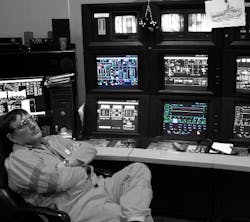But how many are getting hourly reports? What about minute-by-minute reports? Why would anyone subject themselves to that much work and how could it be useful?
Some permits require facilities to install what is known as Continuous Emissions Monitoring Systems (CEMS). These CEMS take readings of emissions from a particular source (or stack) at regular intervals throughout the day, something often required by permits in sensitive cases.
This CEMS data is typically then fed to a summary report or an integrated environmental management software system. Usually, this CEMS data is used to demonstrate ongoing compliance with air regulations.
When Things Go Bad
Many EHS specialists see CEMS as just another step to keeping compliant, and may just meet the bare minimum requirements set out in the permit – sometimes that means taking a recording every 4-6 hours.
Others have seen firsthand how having a minute-to-minute breakdown of emissions can be an essential lifeline when things turn sour. In fact, one EHS manager I’ve worked with used the minute-by-minute report from his CEMS to save his business thousands of dollars and a potential shutdown.
Who knew a few minutes could add up to so much?
One day at his facility, a large piece of machinery and its control equipment suddenly stopped functioning properly, falling out of compliance. Thankfully, this equipment also had a CEMS installed, which took a snapshot of various KPIs (key performance indicators) every minute, even though his permit only required one every 4 hours.
At the end of every hour, the EHS specialist would receive a roll-up report, detailing his KPIs at 1-minute intervals.
The minute-by-minute report showed:
- Exactly which minute the malfunction occurred
- How much the relevant permit conditions were exceeded
- The exact minute the problem was resolved
Improve Your Audit Trail
Instead of waiting 4 hours to check on his equipment, the manager was able to quickly and proactively move to minimize the impact of the malfunction. But even more importantly, the CEMS provided concrete records of exactly how long the malfunction lasted. These records were vital when explaining his noncompliance notification claims to the EPA.
In general, when a malfunction or other noncompliance event occurs, the last thing you want is to do underreport to your regulators. It looks like you’re covering something up that will just get uncovered in a future audit.
But that doesn’t mean you want to over-report,either. All that does it waste your money.
Where many less-informed specialists would have to play it safe and over-report for the 4 hours, this EHS manager had the information he needed to give an exact malfunction period, and only pay penalties for that period.
No over-reporting. No over-paying.
Limiting Your Risk for Non-Compliance
When I spoke with him, that EHS manager said he would have estimated more than triple the noncompliance period if he didn’t have CEMS data to back himself up. He was able to save many thousands of dollars for his company just by collecting environmental compliance data more frequently than expected. The type of data collected and resources required were already implemented at his facility.
Although this setup is not for everyone or every business, minute reports from a CEMS are hands-down the best option for data-driven EHS managers and those who are required to monitor their environmental outputs more than once daily.
If you’re already implementing a form of continuous monitoring, the benefits of minute-to-minute should be obvious. It will save you money, and your regulators will be blown away when you submit your reports.
There will never be any question that your claims of compliance are accurate and verifiable. An environmental report that drills down by the minute doesn’t give you anywhere to hide: It’s the ultimate in EHS transparency and your regulators are sure to appreciate that.


